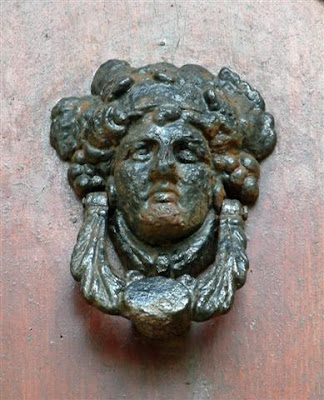St David is the patron saint of Wales. The cathedral built in his honour (in the city named after him) is spectacular. This is a view of the cathedral, as seen from the adjoining Bishop's Palace.

The Cathedral and the Bishops Palace.

A corbel of a woman's head - a queen by the look of that crown. This is to the left of the main entrance to the cathedral.

Her male partner is to the right of the entrance.

Inside the cathedral is a reliquary, said to contain fragments of the bones of St David and also St Justinian, amongst others.

The quality of the stone carving is wonderful.


The floor tiles are beautiful too. There is a random sampling of tile designs here.

The ceilings change as you move from one area of the cathedral to another. This is painted decoration.
And here is some beautiful carved stone tracery, with a coat of arms at the centre.

A similar ceiling, with a different coat of arms.

A spectacularly carved wood ceiling, with suspended figures. It was very late in the day, and the cathedral was quite dark when I took the photograph, which doesn't show much detail. the carving is very detailed, and like lace in places.

The stone arches are large and imposing. Each has a different pattern carved into the stonework of the arch.

The way out.

The cathedral also has a lovely refectory, where you can buy a light meal, a home made cake, and a good cup of tea or coffee. You can also spend some money in the adjoining gallery, where work made by Pembrokeshire artists is on display.

The Cathedral and the Bishops Palace.

A corbel of a woman's head - a queen by the look of that crown. This is to the left of the main entrance to the cathedral.

Her male partner is to the right of the entrance.

Inside the cathedral is a reliquary, said to contain fragments of the bones of St David and also St Justinian, amongst others.

The quality of the stone carving is wonderful.


The floor tiles are beautiful too. There is a random sampling of tile designs here.

The ceilings change as you move from one area of the cathedral to another. This is painted decoration.

And here is some beautiful carved stone tracery, with a coat of arms at the centre.

A similar ceiling, with a different coat of arms.

A spectacularly carved wood ceiling, with suspended figures. It was very late in the day, and the cathedral was quite dark when I took the photograph, which doesn't show much detail. the carving is very detailed, and like lace in places.

The stone arches are large and imposing. Each has a different pattern carved into the stonework of the arch.

The way out.

The cathedral also has a lovely refectory, where you can buy a light meal, a home made cake, and a good cup of tea or coffee. You can also spend some money in the adjoining gallery, where work made by Pembrokeshire artists is on display.














